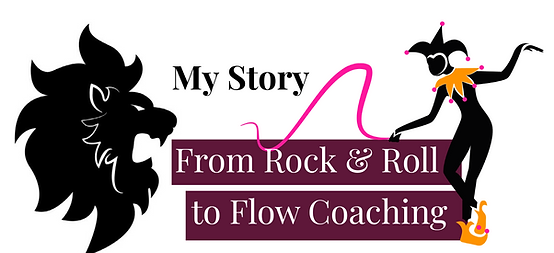

Eleanor O'Rourke
Reconnect with your creative spirit.
It’s been waiting for you.
I help people reclaim their creativity – not just the neat, Instagrammable kind, but the raw, alive energy that lets you solve problems, laugh more, and feel alive again.
I believe creativity isn’t an exclusive gift or a career choice – it’s our natural state. But somewhere along the way between meetings, mortgages and making everyone else happy we lost touch with it.
I’m here to help you get it back

When I was a child, I thought the circus might be my future. It seemed like the only escape from the beige safety of “normal life.” Pretty soon I realised what I longed for wasn’t trapeze acts or lion taming – it was Freedom.
As a young adult, I flirted with a bohemian lifestyle. Again, while this looked interesting, I discovered that identity doesn’t feel like anything. What I really craved was Creativity.
I spent the next ten years as a road manager for rock & roll bands. The hours were insane, the problems endless, but each day, against all odds, the doors opened and the show went on. This is when I discovered the magic of Flow.
After leaving “life on the road,” I worked two decades in marketing and advertising. There I saw how certainty and control – the prized currency of the workplace – often smothered creative freedom.
So I became a coach.
I wanted to encourage people to experience the feeling of freedom and connection that occurs when we move from survival thinking to creative thinking, and thereby access a Flow state.
Flow is the ability to move through life without clinging or resistance. It turns our inner fear into creative power.
So it turns out I wanted the lion taming after all.
What I do
Rewire the left-brain patterns of survival thinking. Reignite the creativity of right-brain intuition. Find Flow.
My methodology is based on identifying and transforming the unconscious archetypal patterns that keep you stuck in overwhelm, decision paralysis, and that low-level hum of "is this all there is?"
I offer this in the form of… Individual coaching; Team coaching; Workshops; Creative Retreats.
Think of me as:
-
🐠 A Babel Fish for leaders navigating a world we don’t yet have words for.
-
🐉 A dragon mother for creatives who’ve lost their fire.
-
🌊 A flow coach for anyone ready to move beyond fear into freedom.


Why Flow Matters
This isn't optional anymore. It's the consciousness jump leads we need to thrive in what's coming next.
Remember how the internet changed everything? We’re on the edge of another seismic shift – artificial intelligence is reshaping our world at warp speed. The next unfair advantage won’t be individual creativity (AI can do that now). It will be something AI can’t deliver: Flow.
Flow is where creativity and humanity meet. In flow:
-
✨ Your senses sharpen.
-
❤️ Your heart expands.
-
🛡 Fear softens into courage.
This isn’t about hustling harder. It’s about reconnecting with the energy that makes new possibilities feel… possible.
““I operate at senior level with multinationals, many of whom struggle with transformation and sustainable behavioural change. In my many years in this field I have never met anyone with the unique talent and skill in this area as Eleanor.
She has an uncanny ability to make the invisible visible; to see the patterns within the patterns. After working with her individually, I brought her in to work with a team of 8. The level of connection and creativity they now share is wonderful to witness."
"I’d been writing for 25 years, when I was hit by a huge writer’s block. Eleanor’s insights were invaluable, allowing me to look at things from a different perspective.
She helped me go deeper in myself to find the book that I didn’t even know was there.
If you are an artist of ANY type, this will take you to new levels. And her take on archetypes will rock your world in the very best way!."
“I’ve worked with many coaches and therapists, but I understood and cleared more in one session than in a year of therapy. She has so much knowledge about where you’re at, what your real needs are and how to get you to where you want to be.
Eleanor asks the tough questions, the soul searching, epiphany blazing questions that shake you to your core. But she does this in a loving and accepting way. It took me off the ‘automatic pilot’ I didn’t even know I was running on. Also she is divinely funny.”


